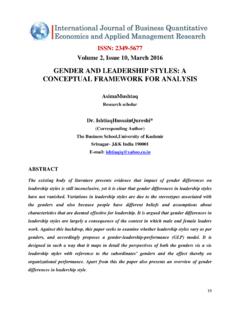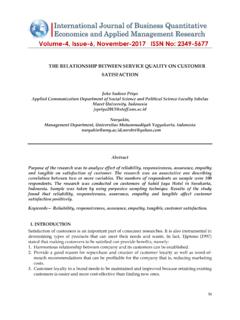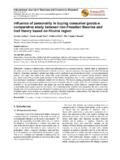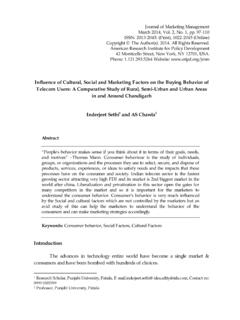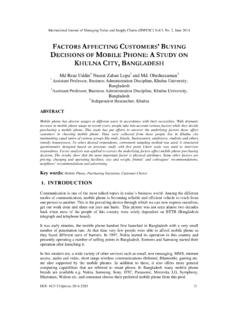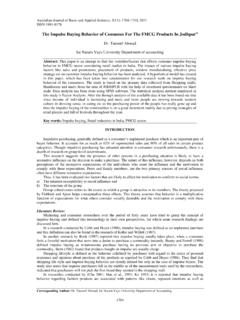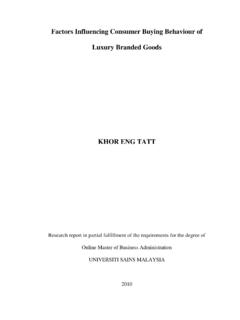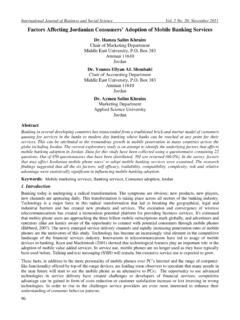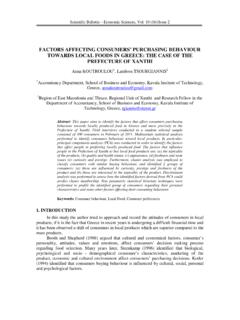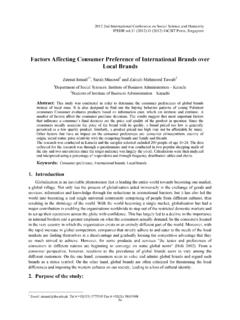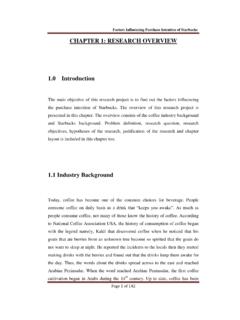Transcription of Factors affecting buying behavior in E-commerce in India ...
1 ISSN: 2349-5677 Volume 2, Issue 2, July 2015 56 Factors affecting buying behavior in E-commerce in India : A review of literature Debnath Burman and Dr. Artee Aggrawal I. Introduction buying behavior of consumers in India his changing and education, age, income, economic scenario, media and technology is playing a predominant role in shaping the way people shop. Indian consumer today is more educated. The fact that a large chunk of these customers are youth is changing the way people are shopping and this has a direct implication on various aspects of shopping such as the choice of brands. The Indian retail industry is presently one of the world's top five retail markets in terms of economic value and the industry is experiencing exponential growth, with retail development taking place not just in major cities and metros, but also in smaller towns.
2 According to a report, rapid urbanization and lifestyle changes have increased time-starved consumers exponentially and the segment that values convenience has behavior of BoP (bottom of the pyramid) consumers who have an average household income below Rs 1,00,000 a year has also changed thanks to impact of government schemes. The segment, however, still remains largely untapped, and local influencers seem to determine the purchasing habits when it comes to the BoP segment in small youth constitutes a considerable proportion of the online users, and growth in online retail has been driven by increased value consciousness, small city aspirations and growing importance of convenience. Retailers are focusing on satisfaction on key service parameters and loyalty, which can be driven by strengthening front end operations.
3 Though high-end segments such as apparel and consumer electronics dominate the online retail segment, new segments are increasingly gaining popularity. The growth of categories such as grocery retailing can be attributed to a mix of increasing comfort with trying new 'non-traditional' categories coupled with improved value. Urban markets, which refers to locations apart from top tier cities that are vastly untapped, are home to the majority of the Indian market and consists of a large number of heterogonous sub-groups that remain largely underserved and ISSN: 2349-5677 Volume 2, Issue 2, July 2015 57 are characterized by increased brand consciousness. The urban segment has consumers adopting newer channels of purchase to overcome inherent purchase barriers. Online players have also stepped in to fill the demand-supply gap created by the lack of physical stores in these cities.
4 With growing brand awareness, consumers today are bewildered with the product brands as well as E-commerce sites. Not much of literature is present to understand the impact of these various E-commerce sites on the selling of various products therefore the present study is designed to understand the Factors affecting buying behavior of the E-commerce customers and the role of branding of E-commerce sites in obtaining large sales volumes. II. Objectives of the Study The objective of the paper is to understand the consumer s perspective the Factors affecting buying behavior of the E-commerce customers and the role of branding of E-commerce sites in obtaining large sales volumes. Keeping in view the main objectives of the study the review of various existing studies has been taken into consideration for the purpose of understanding the variables related to the buying behavior of the consumers in E-commerce in India .
5 Research Methodology: Various building blocks of the research work are as under: Nature of Research: The present research is qualitative in nature as it explores the existing literature related to the Factors affecting buying behavior in E-commerce in India . Data Collection: Since the nature of research is qualitative, the data for Factors affecting buying behavior in E-commerce in India will be collected mainly from government websites and various research papers on the present topic. Analysis Scheme: Various themes from the data would be extracted for the purpose of deeper understanding of the subject. III. Literature Review It has been established that the consumer buying behavior is the outcome of the needs and wants of the consumer and they purchase to satisfy these needs and wants. Although it sounds simple ISSN: 2349-5677 Volume 2, Issue 2, July 2015 58 and clear, these needs can be various depending on the personal Factors such as age, psychology and personality.
6 Also there are some other external Factors which are broad and beyond the control of the consumer. A number of researches have been carried out by academics and scholars on identifying and analyzing those Factors affecting the consumers buying behavior and as a result, various types of Factors have been identified. These Factors have been classified into different types and categories in different ways by different authors. For instance, Wiedermann et al (2007) classified them into internal and external factor. On the other hand, Winer (2009) divided them into social, personal and psychological Factors . Despite the fact that they have been classified into different groups by different authors they are similar in scope and purpose (Rao, 2007). A consumer s buying behavior is influenced by cultural, social, personal and psychological Factors .
7 Most of these Factors are uncontrollable and beyond the hands of marketers but they have to be considered while trying to understand the complex behavior of the consumers. Consumer is the study of the processes involved when individuals or groups select, purchase, use, or dispose of products, services, ideas, or experiences to satisfy needs and desires (Solomon 1995, 7). In the marketing context, the term consumer refers not only to the act of purchase itself, but also to patterns of aggregate buying which include pre-purchase and post-purchase activities. Pre-purchase activity might consist of the growing awareness of a need or want, and a search for and evaluation of information about the products and brands that might satisfy it. Post-purchase activities include the evaluation of the purchased item in use and the reduction of any anxiety which accompanies the purchase of expensive and infrequently-bought items.
8 Each of these has implications for purchase and repurchase and they are amenable in differing degrees to marketer influence (Foxall 1987). Engel, et al. (1986, 5) define consumer behavior as those acts of individuals directly involved in obtaining, using and disposing of economic goods and services, including the decision processes that precede and determine these acts . Simple observation provides limited insight into the complex nature of consumer choice and researchers have increasingly sought the more sophisticated concepts and methods of investigation provided by behavioral sciences in order to understand, predict, and possibly control consumer behavior more effectively. The topic of consumer behavior is one of the massively studied topics by the researchers Psychology, social psychology, and sociology are the disciplines most widely employed in this ISSN: 2349-5677 Volume 2, Issue 2, July 2015 59 Endeavour which has become a substantial academic industry in its own paper presents a review of the literature, in the field of consumer buying behavior .
9 It is worth noting that consumer buying behavior is studied as a part of the marketing and its main objective it to learn the way how the individuals, groups or organizations choose, buy use and dispose the goods and the Factors such as their previous experience, taste, price and branding on which the consumers base their purchasing decisions (Kotler and Keller, 2012). One of such studies of consumer buying behavior has been conducted by Acebron et al (2000). The aim of the study was to analyze the impact of previous experience on buying behavior of fresh foods, particularly mussels. In their studies the authors used structural equation model in order to identify the relationship between the habits and previous experience on the consumer buying decision. Their findings show that personal habits and previous experience on of the consumers have a direct impact on the consumers purchase decision in the example of purchasing fresh mussels.
10 They also found that the image of the product has a crucial impact on the purchasing decision of the consumer and further recommended that the product image should continuously be improved in order to encourage the consumers towards purchasing. Another study conducted by Variawa (2010) analyzed the influence of packaging on consumer decision making process for Fast Moving Consumer Goods. The aim of the research was to analyze the impact of packaging for decision making processes of low-income consumers in retail shopping. A survey method has been used in order to reach the research objectives. In a survey conducted in Star Hyper in the town of Canterville 250 respondents participated. The findings of the research indicate that low-income consumers have more preferences towards premium packaging as this can also be re-used after the product has been consumed.
